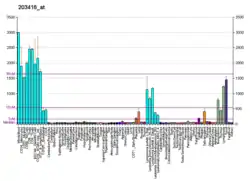CD53
Leukocyte surface antigen CD53 is a protein that in humans is encoded by the CD53 gene.[5][6]
| CD53 | |||||||||||||||||||||||||||||||||||||||||||||||||||
|---|---|---|---|---|---|---|---|---|---|---|---|---|---|---|---|---|---|---|---|---|---|---|---|---|---|---|---|---|---|---|---|---|---|---|---|---|---|---|---|---|---|---|---|---|---|---|---|---|---|---|---|
| Identifiers | |||||||||||||||||||||||||||||||||||||||||||||||||||
| Aliases | CD53, MOX44, TSPAN25, CD53 molecule | ||||||||||||||||||||||||||||||||||||||||||||||||||
| External IDs | OMIM: 151525 MGI: 88341 HomoloGene: 20152 GeneCards: CD53 | ||||||||||||||||||||||||||||||||||||||||||||||||||
| |||||||||||||||||||||||||||||||||||||||||||||||||||
| |||||||||||||||||||||||||||||||||||||||||||||||||||
| |||||||||||||||||||||||||||||||||||||||||||||||||||
| |||||||||||||||||||||||||||||||||||||||||||||||||||
| |||||||||||||||||||||||||||||||||||||||||||||||||||
| Wikidata | |||||||||||||||||||||||||||||||||||||||||||||||||||
| |||||||||||||||||||||||||||||||||||||||||||||||||||
The protein encoded by this gene is a member of the transmembrane 4 superfamily, also known as the tetraspanin family. Most of these members are cell-surface proteins that are characterized by the presence of four hydrophobic domains. The proteins mediate signal transduction events that play a role in the regulation of cell development, activation, growth and motility. This encoded protein is a cell surface glycoprotein that is known to complex with integrins. It contributes to the transduction of CD2-generated signals in T cells and natural killer cells and has been suggested to play a role in growth regulation. Familial deficiency of this gene has been linked to an immunodeficiency associated with recurrent infectious diseases caused by bacteria, fungi and viruses. Alternative splicing results in multiple transcript variants encoding the same protein.[6]
See also
References
- GRCh38: Ensembl release 89: ENSG00000143119 - Ensembl, May 2017
- GRCm38: Ensembl release 89: ENSMUSG00000040747 - Ensembl, May 2017
- "Human PubMed Reference:". National Center for Biotechnology Information, U.S. National Library of Medicine.
- "Mouse PubMed Reference:". National Center for Biotechnology Information, U.S. National Library of Medicine.
- Korinek V, Horejsi V (Jul 1993). "Genomic structure of the human CD53 gene". Immunogenetics. 38 (4): 272–279. doi:10.1007/BF00188803. PMID 8319976. S2CID 6683727.
- "Entrez Gene: CD53 CD53 molecule".
Further reading
- Horejsí V, Vlcek C (1991). "Novel structurally distinct family of leucocyte surface glycoproteins including CD9, CD37, CD53 and CD63". FEBS Lett. 288 (1–2): 1–4. doi:10.1016/0014-5793(91)80988-F. PMID 1879540. S2CID 26316623.
- Berditchevski F (2002). "Complexes of tetraspanins with integrins: more than meets the eye". J. Cell Sci. 114 (Pt 23): 4143–51. doi:10.1242/jcs.114.23.4143. PMID 11739647.
- Bell GM, Seaman WE, Niemi EC, Imboden JB (1992). "The OX-44 molecule couples to signaling pathways and is associated with CD2 on rat T lymphocytes and a natural killer cell line". J. Exp. Med. 175 (2): 527–536. doi:10.1084/jem.175.2.527. PMC 2119111. PMID 1346273.
- Angelisová P, Vlcek C, Stefanová I, et al. (1990). "The human leucocyte surface antigen CD53 is a protein structurally similar to the CD37 and MRC OX-44 antigens". Immunogenetics. 32 (4): 281–285. doi:10.1007/BF00187099. PMID 1700763. S2CID 42139537.
- Amiot M (1991). "Identification and analysis of cDNA clones encoding CD53. A pan-leukocyte antigen related to membrane transport proteins". J. Immunol. 145 (12): 4322–5. PMID 2258620.
- Dianzani U, Bragardo M, Buonfiglio D, et al. (1995). "Modulation of CD4 lateral interaction with lymphocyte surface molecules induced by HIV-1 gp120". Eur. J. Immunol. 25 (5): 1306–1311. doi:10.1002/eji.1830250526. PMID 7539755. S2CID 37717142.
- Carmo AM, Wright MD (1995). "Association of the transmembrane 4 superfamily molecule CD53 with a tyrosine phosphatase activity". Eur. J. Immunol. 25 (7): 2090–2095. doi:10.1002/eji.1830250743. PMID 7621882. S2CID 44551148.
- Rasmussen AM, Blomhoff HK, Stokke T, et al. (1994). "Cross-linking of CD53 promotes activation of resting human B lymphocytes". J. Immunol. 153 (11): 4997–5007. PMID 7963560.
- Gonzalez ME, Pardo-Manuel de Villena F, Fernandez-Ruiz E, et al. (1994). "The human CD53 gene, coding for a four transmembrane domain protein, maps to chromosomal region 1p13". Genomics. 18 (3): 725–728. doi:10.1016/S0888-7543(05)80385-4. hdl:10261/72861. PMID 8307585.
- Olweus J, Lund-Johansen F, Horejsi V (1993). "CD53, a protein with four membrane-spanning domains, mediates signal transduction in human monocytes and B cells". J. Immunol. 151 (2): 707–16. PMID 8335905.
- Taguchi T, Bellacosa A, Zhou JY, et al. (1993). "Chromosomal localization of the Ox-44 (CD53) leukocyte antigen gene in man and rodents". Cytogenet. Cell Genet. 64 (3–4): 217–221. doi:10.1159/000133580. PMID 8404042.
- Virtaneva KI, Angelisová P, Baumruker T, et al. (1993). "The genes for CD37, CD53, and R2, all members of a novel gene family, are located on different chromosomes". Immunogenetics. 37 (6): 461–465. doi:10.1007/BF00222471. hdl:10138/157839. PMID 8436422. S2CID 8899453.
- Wright MD, Rochelle JM, Tomlinson MG, et al. (1993). "Gene structure, chromosomal localization, and protein sequence of mouse CD53 (Cd53): evidence that the transmembrane 4 superfamily arose by gene duplication". Int. Immunol. 5 (2): 209–216. doi:10.1093/intimm/5.2.209. PMID 8452817.
- Mannion BA, Berditchevski F, Kraeft SK, et al. (1996). "Transmembrane-4 superfamily proteins CD81 (TAPA-1), CD82, CD63, and CD53 specifically associated with integrin alpha 4 beta 1 (CD49d/CD29)". J. Immunol. 157 (5): 2039–47. PMID 8757325.
- Szöllósi J, Horejsí V, Bene L, et al. (1996). "Supramolecular complexes of MHC class I, MHC class II, CD20, and tetraspan molecules (CD53, CD81, and CD82) at the surface of a B cell line JY". J. Immunol. 157 (7): 2939–46. PMID 8816400.
- Okochi H, Kato M, Nashiro K, et al. (1998). "Expression of tetra-spans transmembrane family (CD9, CD37, CD53, CD63, CD81 and CD82) in normal and neoplastic human keratinocytes: an association of CD9 with alpha 3 beta 1 integrin". Br. J. Dermatol. 137 (6): 856–863. doi:10.1111/j.1365-2133.1997.tb01544.x. PMID 9470900.
- Nichols TC, Guthridge JM, Karp DR, et al. (1999). "Gamma-glutamyl transpeptidase, an ecto-enzyme regulator of intracellular redox potential, is a component of TM4 signal transduction complexes". Eur. J. Immunol. 28 (12): 4123–4129. doi:10.1002/(SICI)1521-4141(199812)28:12<4123::AID-IMMU4123>3.0.CO;2-G. PMID 9862348. S2CID 1333672.
- Serru V, Le Naour F, Billard M, et al. (1999). "Selective tetraspan-integrin complexes (CD81/alpha4beta1, CD151/alpha3beta1, CD151/alpha6beta1) under conditions disrupting tetraspan interactions". Biochem. J. 340 (1): 103–11. doi:10.1042/0264-6021:3400103. PMC 1220227. PMID 10229664.
External links
- CD53+protein,+human at the U.S. National Library of Medicine Medical Subject Headings (MeSH)
- Human CD53 genome location and CD53 gene details page in the UCSC Genome Browser.
This article incorporates text from the United States National Library of Medicine, which is in the public domain.




